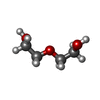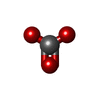+Search query
-Structure paper
| Title | Active site metals mediate an oligomeric equilibrium in Plasmodium M17 aminopeptidases. |
|---|---|
| Journal, issue, pages | J Biol Chem, Vol. 296, Page 100173, Year 2021 |
| Publish date | Dec 17, 2020 |
 Authors Authors | Tess R Malcolm / Matthew J Belousoff / Hariprasad Venugopal / Natalie A Borg / Nyssa Drinkwater / Sarah C Atkinson / Sheena McGowan /  |
| PubMed Abstract | M17 leucyl aminopeptidases are metal-dependent exopeptidases that rely on oligomerization to diversify their functional roles. The M17 aminopeptidases from Plasmodium falciparum (PfA-M17) and ...M17 leucyl aminopeptidases are metal-dependent exopeptidases that rely on oligomerization to diversify their functional roles. The M17 aminopeptidases from Plasmodium falciparum (PfA-M17) and Plasmodium vivax (Pv-M17) function as catalytically active hexamers to generate free amino acids from human hemoglobin and are drug targets for the design of novel antimalarial agents. However, the molecular basis for oligomeric assembly is not fully understood. In this study, we found that the active site metal ions essential for catalytic activity have a secondary structural role mediating the formation of active hexamers. We found that PfA-M17 and Pv-M17 exist in a metal-dependent dynamic equilibrium between active hexameric species and smaller inactive species that can be controlled by manipulating the identity and concentration of metals available. Mutation of residues involved in metal ion binding impaired catalytic activity and the formation of active hexamers. Structural resolution of Pv-M17 by cryoelectron microscopy and X-ray crystallography together with solution studies revealed that PfA-M17 and Pv-M17 bind metal ions and substrates in a conserved fashion, although Pv-M17 forms the active hexamer more readily and processes substrates faster than PfA-M17. On the basis of these studies, we propose a dynamic equilibrium between monomer ↔ dimer ↔ tetramer ↔ hexamer, which becomes directional toward the large oligomeric states with the addition of metal ions. This sophisticated metal-dependent dynamic equilibrium may apply to other M17 aminopeptidases and underpin the moonlighting capabilities of this enzyme family. |
 External links External links |  J Biol Chem / J Biol Chem /  PubMed:33303633 / PubMed:33303633 /  PubMed Central PubMed Central |
| Methods | EM (single particle) / X-ray diffraction |
| Resolution | 2.33 - 2.66 Å |
| Structure data | EMDB-22682, PDB-7k5k:  PDB-6wvv: |
| Chemicals |  ChemComp-GOL:  ChemComp-PEG:  ChemComp-ZN:  ChemComp-SO4:  ChemComp-HOH:  ChemComp-CO3:  ChemComp-MN: |
| Source |
|
 Keywords Keywords | HYDROLASE / M17 Leucyl Aminopeptidase / Metalloprotease / M17 aminopeptidase / leucyl aminopeptidase |
 Movie
Movie Controller
Controller Structure viewers
Structure viewers About Yorodumi Papers
About Yorodumi Papers






